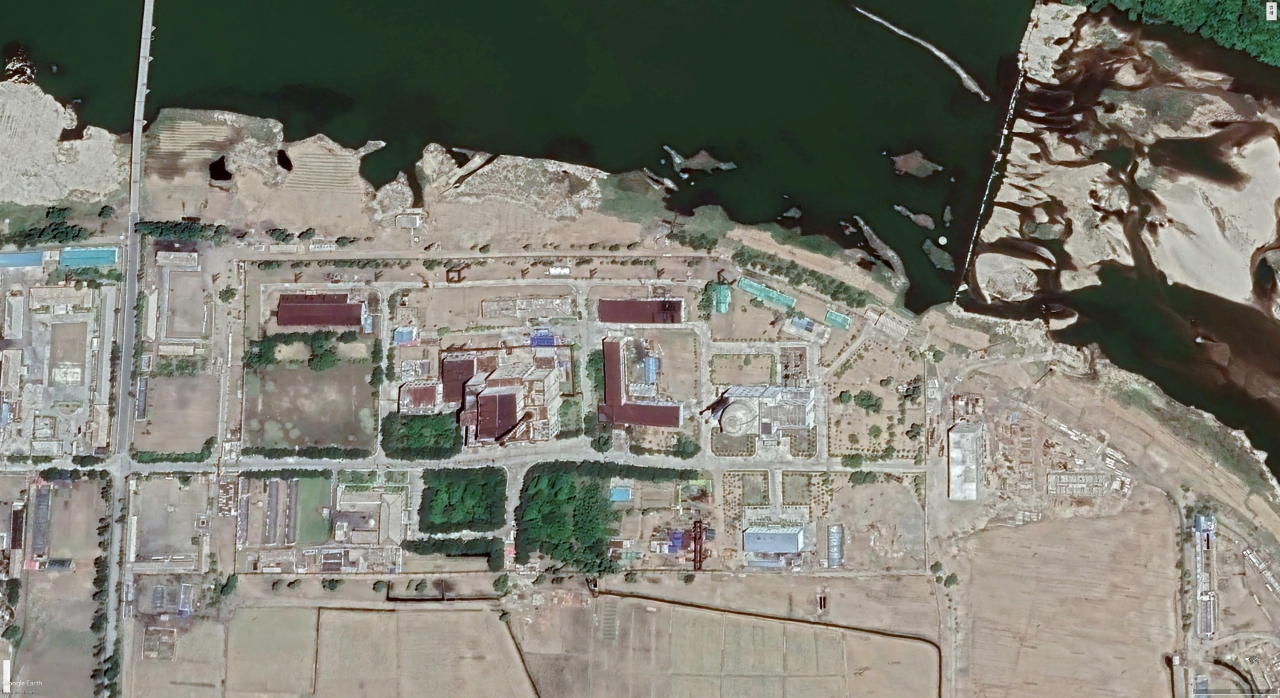
North Korea’s Yongbyon Nuclear Scientific Research Center (Google Earth)
Satellite imagery shows that North Korea’s main plutonium-producing nuclear reactor at the Yongbyon nuclear complex is in operation, a Washington-based think tank reported Tuesday.
The 5-megawatt reactor has continued to operate to produce weapons-grade plutonium despite heavy rains over the past several weeks, according to 38 North, a US website monitoring North Korea, based on commercial satellite imagery collected on July 5.
The satellite imagery analysis is in line with the recent assessment of the International Atomic Energy Agency. The IAEA chief in June said the 5-megawatt nuclear reactor seems to have been operating since July 2021.
“At the 5 MWe Reactor, cooling water discharge has been observed throughout May and June and continues in July, as indicated by cooling water discharge,” 38 North said.
“The heavy rains over the past 40 days do not appear to have caused any complications to reactor operations as of yet, although water levels are rising, and work is underway throughout the center to help prevent severe flooding.”
But 38 North warned that increased humidity and continued rain may cause damage to some facilities at the Yongbyon nuclear complex. Furthermore, constant heavy rain could cause flooding of critical facilities later this summer, which may lead to impeding the production of fissile materials for nuclear weapons.
Coal plant running 38 North also said it observed a plume of smoke emanating from the stack of a coal-fired thermal plant, located near the radiochemical laboratory for its reprocessing campaign, for the first time in a year in the July 5 satellite image.
The thermal plant provides necessary heat for the radiochemical laboratory and the co-located radioactive waste handling facilities. Pyongyang can extract plutonium for use in nuclear weapons at the radiochemical laboratory by reprocessing spent nuclear fuel rods obtained from the 5-megawatt nuclear reactor.
The smoke was last seen from the stack in July 2021, which overlapped with the end of North Korea’s spent-fuel reprocessing campaign carried out between February and July last year.
Emissions were not visible in the imagery from July 3, as the Washington-based Center for Strategic and International Studies reported Monday in its online report.
But 38 North said additional monitoring is needed to assess the implications of the activities at the reprocessing site.
“It is too early to conclude whether a new reprocessing campaign has commenced or if steam is being produced for the radioactive waste handling facilities,” the US think tank said. “The steam could also be used to remove humidity from the process buildings caused by excessive rainfall.”
The satellite imagery analysis by 38 North also identified new excavation activity at a suspected nuclear waste storage facility, dubbed Building 500, echoing the previous assessment of the CSIS.
The excavation activity could indicate North Korea’s efforts to “refurbish the facility, or possible early stages of building expansion or modification.”
(dagyumji@heraldcorp.com)

![[Exclusive] Korean military set to ban iPhones over 'security' concerns](http://res.heraldm.com/phpwas/restmb_idxmake.php?idx=645&simg=/content/image/2024/04/23/20240423050599_0.jpg&u=20240423183955)




![[Pressure points] Leggings in public: Fashion statement or social faux pas?](http://res.heraldm.com/phpwas/restmb_idxmake.php?idx=645&simg=/content/image/2024/04/23/20240423050669_0.jpg&u=)